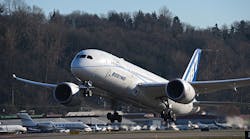In the hunt for even more sustainable jet fuel sources, Boeing (IW 500/13) (BA) has turned to green diesel.
A fuel made from vegetable oil, waste cooking oil and waste animal fat, green diesel potentially could cut carbon emissions by 50% to 90% compared to fossil fuel, according to Finland-based Neste Oil, which supplied green diesel to Boeing for a test flight.
During the Dec. 2 test flight, the ecoDemonstrator 787 flew using a blend of 15% green diesel and 85% petroleum jet fuel in the left engine.
"The airplane performed as designed with the green diesel blend, just as it does with conventional jet fuel," said Capt. Mike Carriker, chief pilot, product development and 777X, Boeing test and evaluation. "This is exactly what we want to see in flight tests with a new type of fuel."
Through its ecoDemonstrator program, which launched in 2012, Boeing tests new technologies related to weight reduction, fuel efficiency, noise reduction, recycling, aerodynamics and flight operations, employing a different aircraft each year.
In 2014, green diesel was one of 25 technologies tested on Boeing's ecoDemonstrator 787 Dreamliner ZA004. It has a chemistry like that of HEFA, an aviation bioefuel approved in 2011, and is different than biodiesel.
"Green diesel offers a tremendous opportunity to make sustainable aviation biofuel more available and more affordable for our customers," said Julie Felgar, managing director of environmental strategy and integration at Boeing Commercial Airplanes.
As many as 800 million gallons of green diesel could be produced in the U.S., Europe and Asia, which could meet up to 1% of jet fuel needs. And, with U.S. government incentives bringing the eco-fuel’s wholesale cost down to about $3 per gallon, green diesel is nearly cost competitive with petroleum jet fuel, Boeing said.




